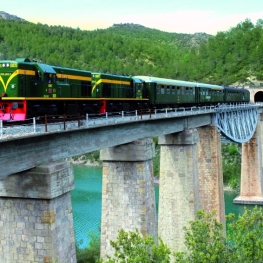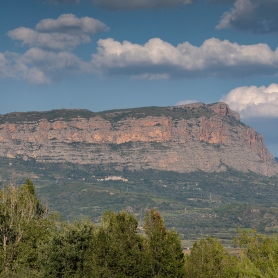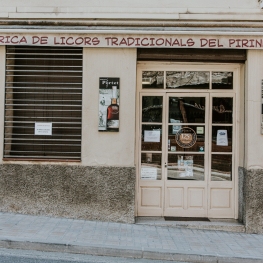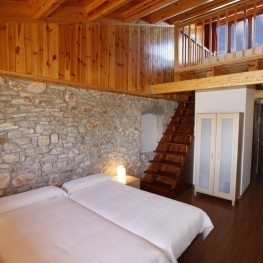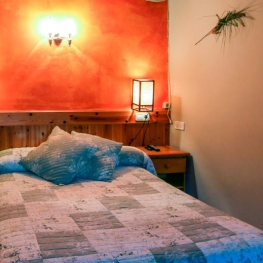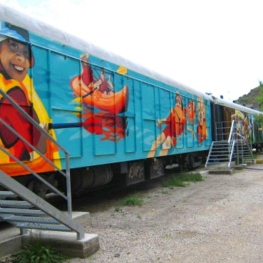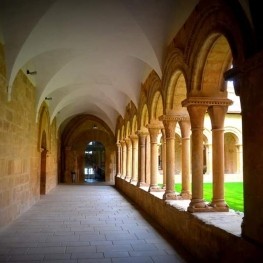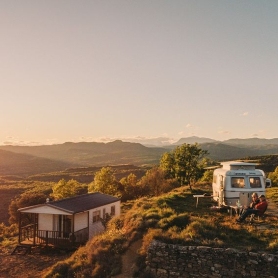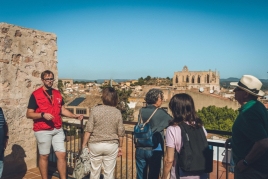Discover the western lands by train

The western lands have a lot to offer: nature, landscape and outdoor activities to relax and discover. In addition, one of its great added values is that the car is not necessary to enjoy. Its places are accessible by public transport, both buses and trains travel through these territories. Therefore, not only can a much more comfortable trip be organized, but it also approaches ecotourism and sustainable tourism in every way .
To link these fantastic landscapes in urban areas and to make communication between towns more fluid, the Railways network of the Generalitat of Catalonia reaches several points of landscape interest. In the regions of Lleida we can find several stations that have very close views full of contrasts and a varied biodiversity. Following the line Lleida - Pyrenees - La Pobla de Segur (RL2) we propose different stops to enter the lands of the west by train.
La Pobla de Segur: Water and Legends
The train station at the door of the Pyrenees of Lleida is located on the other side of the Flamisell River, south of the town's urban center. This station is the last stop of the so-called Lake Train.
La Pobla de Segur enjoys a Raval of medieval origin where the first parish church of the Virgen de la Ribera was built, which has not been preserved until today. What we can find is the new church dedicated to this Virgin, along with a large number of hermitages and chapels throughout its municipality. One of the other characteristic features of the city is the Fossar Vell square and the modernism provided by the Oil Mill (1905) and the Mauri House (1907).
 Although the best known area for nature activities is the territory of Collegats-Boumort, there are several routes that can be done on foot very close to the urban center. One of them is to approach the San Antonio reservoir, also called the Talarn swamp, the deepest freshwater surface in Catalonia. The reservoir was built between 1913 and 1916, and at that time it was the largest water retention outlet in Europe and the fourth in the world.
Although the best known area for nature activities is the territory of Collegats-Boumort, there are several routes that can be done on foot very close to the urban center. One of them is to approach the San Antonio reservoir, also called the Talarn swamp, the deepest freshwater surface in Catalonia. The reservoir was built between 1913 and 1916, and at that time it was the largest water retention outlet in Europe and the fourth in the world.
On the other hand, routes of more than one day can also be made, such as the so-called Fifth Lake route . It is a circular route that winds through the Giganta Dormida, the witchcraft of the Serraspina ridge, the Devil's bridge and the incredible views of the Enchanted House to finally reach Lake Montcortès.
Salàs de Pallars: Nature and Pyrenean Tritons
The Salàs de Pallars station is located in the southeast of the urban center, near the San Antonio Swamp. It is, like many others on this line, an optional stop, that is, you must press the corresponding button to make the train stop and thus get on or off.
The town of Salàs de Pallars has several tourist features. One of them is the wall, composed of three circular towers from the medieval and late medieval times that sought to defend the city from the numerous attacks it suffered in its history. In addition, you can see the headwaters of the Iglésia de San Pedro, a Romanesque building from which nothing else could be preserved, as well as a visit to the Old Commerce Interpretation Center.
Although the villa is very close to the San Antonio reservoir and approaching its clear waters is ideal for any water sport, there are a lot of routes to do on foot and by bike. One of them may be the 5km excursion between Salàs de Pallars and the town of Rivert. Once in Rivert's nucleus, there is the possibility of enjoying the numerous natural sources of this town. The purity of these waters is such that they inhabit a large number of Pyrenean newts, currently in danger of extinction.
Tremp: "Caracoleros" and Vultures
The capital of Pallars Jussà has a station located to the west of the urban center and where you can find bar service in the former building of travelers. In Tremp you can see the Basilica of Santa María de Valldeflors, where there is a replica of the altarpiece located in the crypt of the Sagrada Familia.
On the other hand, for lovers of mountain biking, the City Council of Tremp has a free guide service for the route of the Vultures. It is a circular route that can also be done by car or on foot, as it consists of about 31 kilometers. The route begins at the Orrit Bridge and the first stop will be the Casal de los Vitres, in the Tower of Tamúrcia, which is an observation and study center for these birds of prey. After enjoying the view of the Mirador de la Collada de Torogó, the itinerary continues towards the Espluga de la Sierra and Castellet until you reach the Aulàs oak grove , the largest Catalan Pre-Pyrenean oak grove in flat territory. Finally, the route visits Sapeira, where you can see a colony of vultures from the viewpoint in front of the Turmeda wall . The route thus ends, continuing until again to the Orrit Bridge.
In addition, the municipality of Tremp includes several aggregate cores. One of them is the Palau de Noguera, which although it has a total of 79 people, it also has the Generalitat de Catalunya railway station and is one of the Lagos Train stops. This town had a certain relevance in past times since it controlled a ford of the river, hence it was totally fortified although currently no remains of this construction can be seen. On the other hand, a legend surrounds the hermitage of San Antolín, located one kilometer from the town. It is said that when the hermitage was already built, the townspeople were surprised to see that a ray of light arose from between two stones on the ground. A sage approached and solved the riddle: clarity was the reflection of the gold that was under the church, they just had to bring the church down to find the treasure. And so they did, but in undoing the work done, instead of gold they found a snail. Some voices say that for this reason the inhabitants of Palau de Noguera are called "caracoleros".
Cellers - Llimiana: Bridges and Water Sports

The Cellers - Llimiana station is located in the municipality of Castell and is closer to the Cellers nucleus, since Llimiana is located at the other end of the Terradets reservoir. This station is part of the Lake Train route. Today, the stop is optional.
Currently, the Cellers station building functions as a two-storey, 40-seater hostel and a restaurant. In addition, it is the starting point of several outdoor activities such as walking or mountain biking, kayaking, climbing or even caving.
In fact, from the station, you can start a route that borders the reservoir. On the other hand, the most curious may discover the history of the monastery of San Miguel de Bodegas, which was founded by the counts of Pallars Jussà in 1770 and was submerged in the waters of the reservoir in 1935. Similarly, the old bridge of Monares was surpassed by the swamp, so the bridge that joins the municipal terms of Castell and Llimiana is the so-called new bridge of Monares.
Once you reach Llimiana, you can enjoy this town that is 790m above a rocky peak north of the Sierra del Montsec. From its height, it overlooks the Barcedana Valley, the Terradets Gorge and the Noguera Pallaresa River. Llimiana is located in a privileged situation, a rural environment of mountain slopes that form a very particular orography.
The landscape and its artistic values are remarkable, an example may be one of the largest Romanesque churches in the entire Pyrenees dedicated to Santa Maria. Not forgetting that the extension of the term includes a part of the Montsec de Rúbies where we find several sites of interest: the Muricecs cave , the Black cave of the Montsec, the hermitage of San Salvador del Bosque, the cave of the Ice and the hydroelectric power station of Terradets (1935). Keep in mind that bathing in the reservoir is prohibited except for the areas created for it, the closest bathing area of Cellers and Llimiana is that of the "Pines".
Àger: History and Stars
 Àger train station is 9 kilometers east of the town's urban center and a few meters from the tail of the Camarasa swamp. Despite being an optional stop, it is part of the Lake Train route. In addition, for true train lovers, Ager offers a unique experience: staying in fully remodeled train cars and converted into a colonial house and hostel.
Àger train station is 9 kilometers east of the town's urban center and a few meters from the tail of the Camarasa swamp. Despite being an optional stop, it is part of the Lake Train route. In addition, for true train lovers, Ager offers a unique experience: staying in fully remodeled train cars and converted into a colonial house and hostel.
The inhabitants of Àger live basically from agriculture, dry land and the environment provided by the Montsec massif and the cold winds of the Pyrenees. For culture enthusiasts, this town is an ideal destination, they can enjoy the monumental complex of San Pedro with the Collegiate Church and the castle that mixes the Romanesque and neo-Gothic style, which is located at the highest point of the population. Ornaments, wall paintings and most of the building remain, although it has suffered some damage. Also noteworthy is the large number of hermitages and churches, among which the hermitage of the Virgen de la Piedra stands out, built attached to the mountain using its rocky surface; or the hermitage of the Virgen de la Pertusa located within the fortress of the Castle of San Lorenzo. In Àger we find another important vestige: the Fortress of Las Concluas or Torre de las Tinyosa, built as a surveillance point of the Noguera Ribagorzana. In addition, the municipality also has a series of watchtowers from different eras.
It should be said that Àger is surrounded by nature with spectacular places such as the Mont-rebei gorge and the Sierra del Montsec. For this reason it is one of the favorite places to do astroturism: it is one of the closest villages in the Montsec Astronomical Observatory. The night sky of Montsec enjoys exceptional quality in terms of darkness and little light pollution to observe the stars. So much so that in 2013 a total of twenty-two four municipalities of the Montsec obtained the Starlight tourist destination certificate and eleven of them were also certified as a Starlight Reserve, that is, their excellent sky category was demonstrated .
Photographs made in order of appearance by: Cayetano Roso, Agor53, José Renalias, femturisme.cat.
What to do
Licors Portet 1883
La Pobla de SegurThe visit begins at the Espai Ratafia, a small museum of tools,…
Espai Natura Congost de Mont-rebei
Sant Esteve de la Sarga (a 8.5 Km)Reserve protects almost 600 hectares in the Catalan side: the gorge itself…
Where to eat
Hotel-Restaurant Port d'Àger
Àger (a 2.2 Km)The hotel is designed to accommodate families, friends, and corporate groups, as…
El Dien Restaurant
Vallfogona de Balaguer (a 28.2 Km)We love cooking, and we love our customers to receive on the…
Roch Hotel - Restaurant
Sort (a 25 Km)A small, family-run rural hotel, very welcoming, where its owners (Xavi and…
Where to sleep
Casa de colònies Vagons d’Àger, Fundesplai
Àger (a 7.3 Km)Vagones de Àger is located in the municipality of Àger, in the…
Monestir de les Avellanes
Os de Balaguer (a 14.2 Km)An ancient 12th century abbey adapted to the needs of the 21st…
Eco Càmping Terra del Congost
Tremp (a 13.9 Km)Terra del Congost is an old farm converted into an Eco Camping…
Hotel-Restaurant Port d'Àger
Àger (a 2.2 Km)The hotel is designed to accommodate families, friends, and corporate groups, as…


